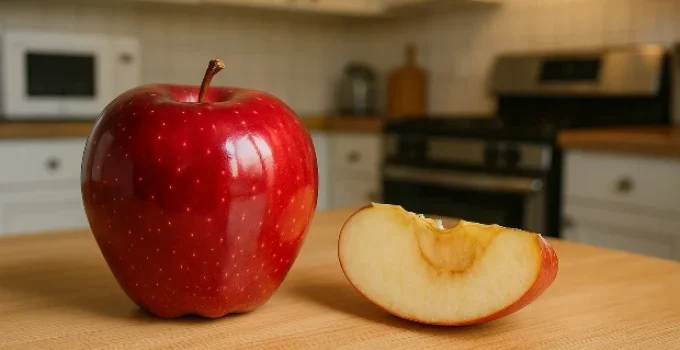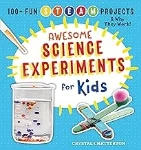Why Do Apples Turn Brown When Cut?
Have you ever sliced an apple only to see it turn brown just minutes later? It might seem like magic—or a sign it’s going bad—but it’s actually a normal chemical process happening right before your eyes. In this article, we’ll uncover the science behind this transformation, explain why it happens, and explore ways to slow it down.
🔎 Dive Deeper
- What Causes Apples to Brown?
- What Is Enzymatic Browning?
- How Does Oxygen Play a Role?
- Why Are Some Apples More Prone to Browning?
- How Can You Prevent Apples from Browning?
- Is It Still Safe to Eat Brown Apples?
- Visual: Enzymatic Browning in Action
- 🎯 Final Thoughts
- 📚 References
What Causes Apples to Brown?
The browning of apples is a chemical reaction triggered by cutting, biting, or damaging the fruit. When the inside of the apple is exposed to air, certain natural compounds in the fruit react and change color.
| Did You Know? |
|---|
| 🍏 According to the USDA, apples are America’s second most consumed fresh fruit after bananas! USDA |
What Is Enzymatic Browning?
The main process behind browning is called enzymatic browning. This happens when enzymes in the apple—especially one called polyphenol oxidase (PPO)—interact with oxygen and compounds called polyphenols. These reactions produce brown pigments called melanins.
| 📊 Enzymatic browning is not limited to apples—it also affects pears, bananas, grapes, potatoes, and even mushrooms, according to the book Enzymes in Food Technology. |
How Does Oxygen Play a Role?
Oxygen is the key to this reaction. When an apple is uncut, oxygen can’t reach the inner cells. But once the skin is broken, oxygen flows in and mixes with the apple’s enzymes and polyphenols, triggering browning almost immediately.
| 🌬️ According to research published in Postharvest Biology and Technology, oxygen exposure leads to visible browning in apple slices within 10–15 minutes. |
Why Are Some Apples More Prone to Browning?
Different apple varieties brown at different rates. For example:
- Granny Smith apples have low PPO activity and brown slowly.
- Red Delicious apples brown more quickly due to higher enzyme levels.
This difference is mostly due to the type and amount of enzymes and polyphenols inside each apple.
| 🧬 A study in Journal of Fruit and Ornamental Plant Research found that PPO activity can vary by over 40% between apple varieties. |
How Can You Prevent Apples from Browning?
You can slow down or stop the browning in several ways:
- Add Lemon Juice: The citric acid lowers pH and slows the enzyme.
- Soak in Salt Water: Salt reduces oxygen exposure.
- Refrigerate: Cold temperatures slow the enzymatic activity.
- Use Antioxidants: Vitamin C can stop the reaction.
| 🍋 According to a study published in Journal of Food Processing and Preservation, a five minute dip in lemon juice can reduce browning by 90-100% when used immediately after cutting. |
Is It Still Safe to Eat Brown Apples?
Yes! Browning does not mean the apple is rotten or harmful. It’s only a surface reaction and does not affect the inside of the fruit unless it’s been exposed for too long or left at room temperature for many hours.
📊 Visual: Enzymatic Browning in Action
| Apple Condition | Color After 15 Minutes | Color After 30 Minutes |
|---|---|---|
| Fresh Cut, No Treatment | Light brown | Medium brown |
| Treated with Lemon Juice | Pale, slight change | Still pale |
| Soaked in Salt Water | Light yellow | Very light brown |
| Refrigerated | Slight change | Light brown |
🎯 Final Thoughts
So, why do apples turn brown when cut? Apples turn brown because of a natural process called enzymatic browning, which starts when the fruit’s cells are exposed to oxygen. It’s not dangerous, but it does change how apples look and taste. Luckily, with simple steps like lemon juice or refrigeration, we can keep our apples fresh-looking and tasty longer!
📚 References
- 📝 Mayer, A. M. “Polyphenol Oxidases in Plants.” Phytochemistry, vol. 18, no. 2, 1979, pp. 193–215. https://doi.org/10.1016/0031-9422(79)80057-6
- 💻 USDA Economic Research Service. “Apples and oranges are the top U.S. fruit choices.” https://www.ers.usda.gov/data-products/chart-gallery/chart-detail?chartId=58322
- 📖 Singh, Balwinder & Suri, Kanchan & Shevkani, Khetan & Kaur, Amritpal & Kaur, Amarbir & Singh, Narpinder. (2018). “Enzymatic Browning of Fruit and Vegetables: A Review: Improvements and Innovations.” Enzymes in Food Technology. https://link.springer.com/chapter/10.1007/978-981-13-1933-4_4.
- Toivonen, Peter & Brummell, David. (2008). “Biochemical bases of appearance and texture changes fresh-cut fruit and vegetables.” Postharvest Biology and Technology. vol. 48. pp. 1-14. https://doi.org/10.1016/j.postharvbio.2007.09.004.
- K oło dz i ej cz yk, K. “Polyphenol Oxidase Activity in Selected Apple Cultivars.” Journal of Fruit and Ornamental Plant Research. Vol. 18(2) 2010: 51-61.
- PIZZOCARO, FRANCESCO & TORREGGIANI, DANILA & GILARDI, GIANLUCA. (2007). Inhibition of apple polyphenoloxidase (PPO) by ascorbic acid, citric acid and sodium chloride. Journal of Food Processing and Preservation. Vol. 17. Pages: 21 – 30. https://doi.org/10.1111/j.1745-4549.1993.tb00223.x.
🎉Related Products
Stunning Chemistry Set – Mega Science Kit with 100+ Easy Experiments
This kit includes all materials needed to conduct 15 stunning chemistry experiments, including building an underwater volcano, create a geyser, and more! Plus a bonus experiment guide with 85+ additional experiments that can all be done with common household items.
Awesome Science Experiments for Kids: 100+ Fun STEM / STEAM Projects and Why They Work
The ultimate science experiment book for kids! 100+ hands-on projects to get kids ages 5 to 10 excited about science.
📌 Learn More About Chemical Reactions
- What Happens If You Mix Baking Soda and Vinegar? 🧪The Science Behind the Fizz
- Is Burning Wood a Chemical Change? 🔥The Science Behind Fire, Ash, and Transformation
- What Makes a Glow Stick Glow?🔥The Cool Chemistry Behind the Glow in the Dark Magic
- What Makes Fireworks Colorful? 🎆 The Chemistry That Lights Up the Sky
- Why Does Iron Rust Over Time? 🌧️ The Science of Metal Decay Uncovered


